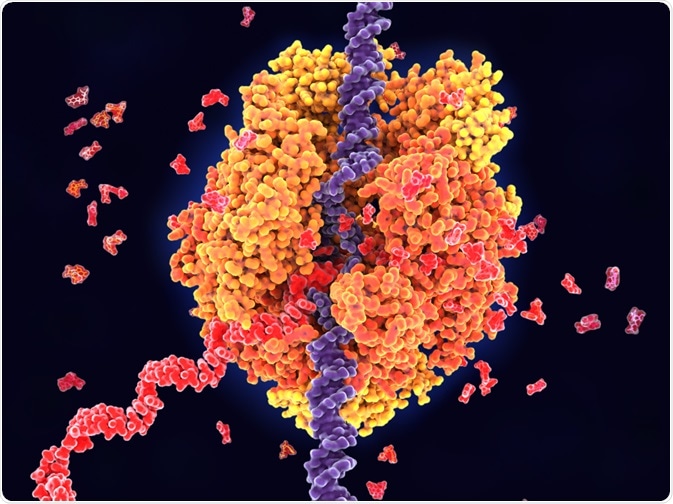Ribonucleic acid (RNA) is an important biological macromolecule that is present in all biological cells.
It is principally involved in the synthesis of proteins, carrying the messenger instructions from DNA, which itself contains the genetic instructions required for the development and maintenance of life. In some viruses, RNA, rather than DNA, carries genetic information.

Image Credit: Juan Gaertner/Shutterstock.com
RNA vs DNA
There are two distinct types of nucleic acid: DNA and RNA. The nucleic acid of DNA is deoxyribose, whereas the nucleic acid of RNA is ribose. As demonstrated by their names, the deoxyribose of DNA lacks one oxygen molecule as compared to the ribose sugar of RNA. The nucleotides that comprise DNA include adenine (A), guanine (G), cytosine (C) and thymine (T), whereas RNA nucleotides include A, G, C and uracil (U).
While the structure of DNA is a double-helix in eukaryotic cells, RNA is typically single-stranded and comes in various forms. The single-stranded structure of RNA allows this molecule to fold back on itself and form various stable secondary structures as necessary.
Types of RNA and their roles
The type of RNA dictates the function that this molecule will have within the cell. Aside from the coding region of messenger RNA (mRNA) molecules that will be translated into proteins, other cellular RNA elements are involved in different processes, which include transcriptional and post-transcriptional regulation of genetic material, temperature and ligand sensing, translation control and RNA turnover.
Transcription (DNA to mRNA)
Since DNA cannot leave the nucleus, it is unable to generate a protein on its own. The generation of proteins from their DNA coding sequence begins with a process called transcription. During transcription, several enzymes, including helicase and topoisomerase, unwind DNA to provide access to another enzyme known as RNA polymerase. RNA polymerase travels along the unwound DNA strand to construct the mRNA molecule until it is ready to leave the nucleus.
Translation (mRNA to protein)
Once mRNA exits the nucleus and enters the cytoplasm of the cell, it will find a ribosome so that the process of translation can begin. A pair of three nucleotide bases of the mRNA molecule is referred to as a codon, and each codon is specific for only one amino acid.
During translation, transfer RNA (tRNA) molecules, which are attached to a particular amino acid, will recognize a codon on the mRNA molecule and insert the appropriate amino acid at that location within the strand. For example, the codon CUC will generate the amino acid leucine, whereas the codon UGA is one type of stop codon that indicates the translation of the gene has been completed. The other two stop codons are UAG and UAA.
Ribosomes contain both proteins and several different ribosomal RNA (rRNA) molecules. Once amino acids have been generated, rRNA molecules will move along the mRNA molecule to catalyze the formation of proteins. It is important to note that mRNA, tRNA, and rRNA all play important roles in this protein-synthesizing pathway.
What is RNA | Genetics | Biology | FuseSchool
RNA as a biological catalyst
Although it was widely believed for many years that only proteins could be enzymes, certain RNA molecules have been shown to adopt complex tertiary structures and act as biological catalysts. For example, rRNA molecules can function as ribozymes during translation.
Ribozymes, which are enzymes comprised of RNA molecules rather than proteins, exhibit many of the features of a classical enzyme, such as an active site, a binding site for a substrate and a binding site for a cofactor, such as a metal ion. Ribozymes link amino acids during protein synthesis, as well as participating in RNA splicing, transfer RNA biosynthesis, and viral replication.
One of the first ribozymes to be discovered was RNase P, a ribonuclease that is involved in generating tRNA molecules from larger, precursor RNAs. RNase P is composed of both RNA and protein; however, the RNA moiety alone is the catalyst.
RNA World Hypothesis
The RNA world hypothesis also referred to as the “RNA 1st” hypothesis, is that life on Earth first evolved with a simple RNA molecule that could individually self-replicate, which DNA later evolved from. Perhaps the strongest evidence for this hypothesis is that the ribosome, where proteins are assembled, is a ribozyme.
Other evidence is the fact that certain viruses use RNA. As viruses are thought to be a simpler, older form of life than the more complex prokaryotic and eukaryotic cells, this would suggest that life first emerged from the prebiotic world through the utilization of this simple nucleic acid for the storage and transcription of information. Thus, replication of these simple lifeforms and the propagation and evolution of more complex organisms was made possible in this ancient world.
Sources
- Incarnato, D., & Oliviero, S. (2017). The RNA Epistructurome: Uncovering RNA Function by Studying Structure and Post-Transcriptional Modifications. Trends in Biotechnology 35(4); 318-333.https://www.ncbi.nlm.nih.gov/pubmed/27988057
- Neveu, M et al. (2013), The “Strong” RNA World Hypothesis: Fifty Years Old, Astrobiology vol. 13 Issue 4 pgs. 391-403, https://doi.org/10.1089/ast.2012.0868
- Copley, S.D et al. (2007), The origin of the RNA world: Co-evolution of genes and metabolism, Bioorganic Chemistry Vol. 35, Issue 6 pgs. 430-443, https://doi.org/10.1016/j.bioorg.2007.08.001
Further Reading